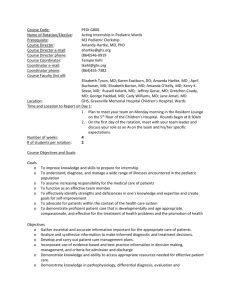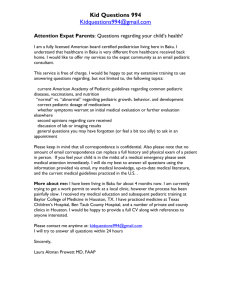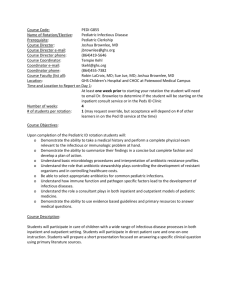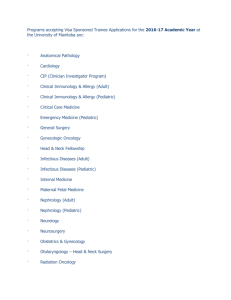CHNOLA Pediatric ED - School of Medicine
advertisement
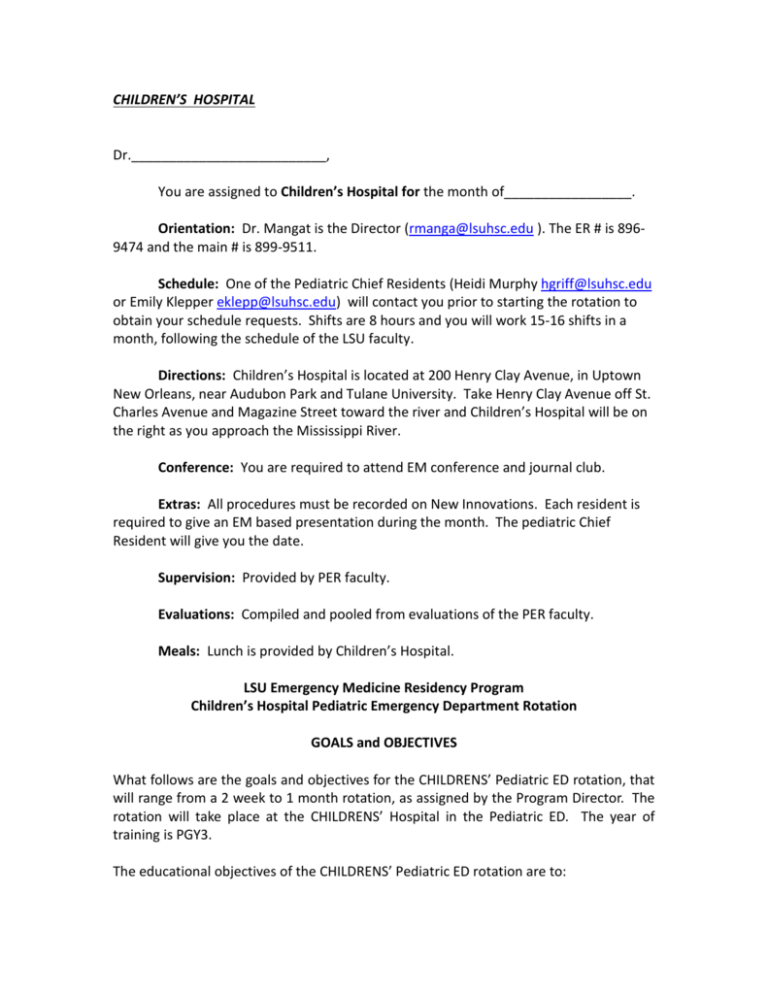
CHILDREN’S HOSPITAL Dr.__________________________, You are assigned to Children’s Hospital for the month of_________________. Orientation: Dr. Mangat is the Director (rmanga@lsuhsc.edu ). The ER # is 8969474 and the main # is 899-9511. Schedule: One of the Pediatric Chief Residents (Heidi Murphy hgriff@lsuhsc.edu or Emily Klepper eklepp@lsuhsc.edu) will contact you prior to starting the rotation to obtain your schedule requests. Shifts are 8 hours and you will work 15-16 shifts in a month, following the schedule of the LSU faculty. Directions: Children’s Hospital is located at 200 Henry Clay Avenue, in Uptown New Orleans, near Audubon Park and Tulane University. Take Henry Clay Avenue off St. Charles Avenue and Magazine Street toward the river and Children’s Hospital will be on the right as you approach the Mississippi River. Conference: You are required to attend EM conference and journal club. Extras: All procedures must be recorded on New Innovations. Each resident is required to give an EM based presentation during the month. The pediatric Chief Resident will give you the date. Supervision: Provided by PER faculty. Evaluations: Compiled and pooled from evaluations of the PER faculty. Meals: Lunch is provided by Children’s Hospital. LSU Emergency Medicine Residency Program Children’s Hospital Pediatric Emergency Department Rotation GOALS and OBJECTIVES What follows are the goals and objectives for the CHILDRENS’ Pediatric ED rotation, that will range from a 2 week to 1 month rotation, as assigned by the Program Director. The rotation will take place at the CHILDRENS’ Hospital in the Pediatric ED. The year of training is PGY3. The educational objectives of the CHILDRENS’ Pediatric ED rotation are to: 1) Gain expertise in the recognition and management of pediatric emergencies. 2) Gain expertise in pediatric resuscitation, including Pediatric Advanced Life Support, emergent intubation, fluid administration, and drug dosages. 3) Become familiar with the management of non-emergent pediatric conditions which commonly present to the Emergency Department. 4) Gain expertise in the performance of routine procedures such as venipuncture and arterial puncture. 5) Become familiar with pediatric medication dosages. The clinical and didactic experiences used to meet those objectives included daily patient care in the CHILDRENS’ Pediatric ED, along with bedside teaching. The rotating resident is encouraged to attend lectures available at CHILDRENS’ pertaining to the care of the pediatric patient. This rotation experience is part of the greater pediatric emergency medicine curriculum, also including PALS provider and instructor certification and weekly didactics (part of the overall didactic curriculum). The feedback mechanisms and methods used to evaluate the performance of the resident include an end of rotation global evaluation. Immediate feedback may also be given to the resident, and any significant problems will be discussed during the rotation with the LSU EM administration. The resources and facilities in the institution that will be available to each resident include computer access to Up To Date and the LSU Library services, including current texts in pediatrics and emergency medicine. There is a rent free, secure apartment available during the rotation for resident use. The residents will have access to the resources of the hospital including medical texts, medical records and cafeteria. The clinical experiences, duties and responsibilities the resident will have on the rotation: Residents will act as a part of the Emergency Medicine team in a community pediatric hospital under the supervision of a staff physician. The residents will participate in the initial management of emergency department patients, to include pediatric trauma and general medical patients. The relationship that will exist between emergency medicine residents and faculty on the service: The overall goals of resident education and patient care will govern the relationship between faculty and residents. Residents will receive 24 hour supervision while on the rotation. All patient care and medical charts will be reviewed and signed by the ED faculty prior to patient discharge. Duty hours for this rotation will not exceed an average of 60hrs/week, and will include 1 in 7 days off. This rotation summary has been reviewed and agreed to by the service director and LSU Program Director. Children’s ED: Specific Competency Based Goals & Objectives: 1. While in the pediatric ED at Children’s Hospital, the resident will demonstrates skill in “Data Gathering” that includes appropriate focused history and physical exam and ordering and interpretation of ancillary tests (* PC, MK, ICS, PR) 2. While in the pediatric ED at Children’s Hospital, the resident will demonstrate skills in “Problem Solving” that includes appropriate and complete differential diagnosis for an undifferentiated pediatric ED patient. Appropriate organization of data collection in relation to patient management decisions. (* PC, MK, PBL) 3. While in the pediatric ED at Children’s Hospital, the resident will demonstrates skills in “Patient Management” that includes a basic treatment plans and timely recognition of complicated pediatric ED patients. (* PC, MK, SBP) 4. While in the pediatric ED at Children’s Hospital, the resident will demonstrate skill in “Medical Knowledge” appropriate for level of training that demonstrates a basic fund of medical knowledge and the ability to seek the scientific basis for their patient care decisions (*MK, PBL) 5. While in the pediatric ED at Children’s Hospital, the resident will demonstrate technical proficiency in “Procedural Skills” consistent with level of training that includes supervised suturing, abscess I&D, dislocation reductions, ultrasound, pediatric medical and trauma resuscitations,conscious sedation, intubations, central venous access and arterial access. (*PC) 6. While in the pediatric ED at Children’s Hospital, the resident will demonstrate appropriate “Interpersonal and Communication Skills” that includes effective information exchange with patients, their families, and professional associates. Demonstrates appropriate conflict resolution skills. (*ICS, PR) 7. While in the pediatric ED at Children’s Hospital, the resident will demonstrate appropriate “Professionalism” that includes introduces self to patient and/or family. Respectful of patient’s privacy and confidentiality (*PR) 8. While in the pediatric ED at Children’s Hospital, the resident will demonstrates an understanding of a “Systems-Based Practice” that includes understanding basic resources available for care of the pediatric ED patient. (*SBP, PC) 9. While in the pediatric ED at Children’s Hospital, the resident will demonstrate “Practice Based Learning and Improvement” skills that includes use of appropriate information resources (ie, texts, online web sites, etc.) for care of patient (* PBL, PC)

